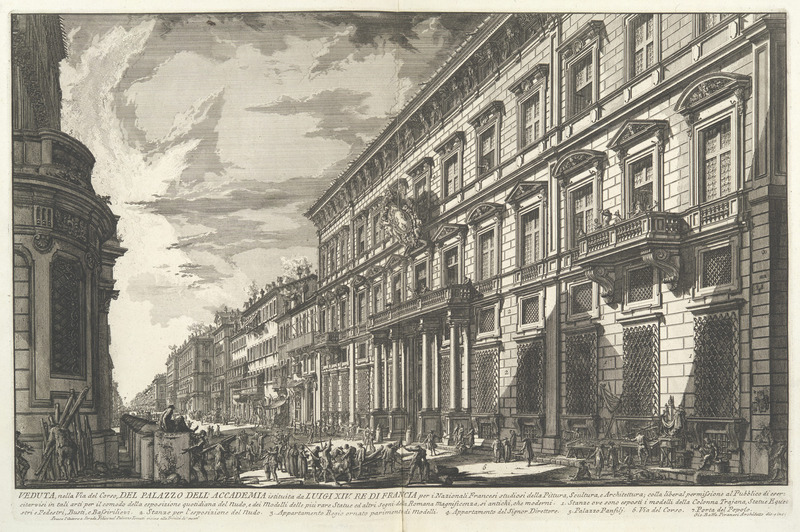Foreign Views of Rome
The idea that Italian art, culture, and society had declined since the ancient times is traceable through many travel journals of those who embarked on the Grand Tour into Rome. No longer as wealthy nor as powerful as it had been in Seicento, Rome and its Papacy suffered severe political and spiritual blows that weakened its stronghold on Roman government until the establishment of the Roman Republic in 1798 ended papal rule.1 That many travel diaries speak of only visiting the ancient ruins and mention next to nothing about contemporary Roman society indicates where the main focuses of these foreign travelers lie, and the lack of interest in Roman urban life is echoed in the entries of more critical travel logs as well.

Giovanni Battista Piranesi, “View along the Via del Corso of the Palazzo dell'Accademia, established by Louis XIV, King of France for French students of Painting, Sculpture and Architecture” from Vedute di Roma part I, 1750-78, etching (Yale University Art Gallery, New Haven).
Tobias Smollett (1721-1771), who traveled to Rome in the late 18th century from Nice commented in his travel journal that the journey often consisted of staying in towns like Sienna, which “stunk,” or passing through beggarly towns like Aqua-Pendente.2 3 Upon his visit to the Campania of Rome, he writes:
[....] the view of this country, in its present situation, cannot but produce emotions of pity and indignation in the mind of every person who retains any idea of its ancient cultivation and fertility. It is nothing but a naked withered down, desolate and dreary, almost without inclosure, cornfield, hedge, tree, shrub, house, hut, or habitation.
Despite all the grand things he had heard of the ancient Roman monuments, he writes that he was “greatly disappointed,” citing the cobblestone streets as uncomfortable for the feet of pedestrians and too narrow for multiple carts to pass through simultaneously.4 Smollett was not the only one to feel this way: Piranesi’s etchings of the Roman monuments, like “View of the Capitoline Hill with the steps to the Church of S. Maria in Aracoeli,” were so dynamic, dramatic, and bold that many who saw his prints before the actual monuments in person were somewhat disenchanted.5 Begrudgingly, Smollett admits that with all the calamities Rome had suffered up to this point, the city still maintains an imperial appearance.6
With the influx of tourists and pilgrims, the local population of Rome swelled so much that the neighborhoods around popular destinations and locations like Piazza di Spagna and via del Corso, Rome’s most fashionable street, were often overcrowded and uncomfortable.7 Sir George Head (1782-1855), who penned a guide to visiting 18th-century Rome, comments that many of the crowded and huddled residences were a result of poorly planned construction during tumultuous times, without regard to public convenience.8
Visitors to Rome often remarked on the sheer volume of idle poor and beggars in the streets. To Sir George Head’s surprise, the profession of soliciting alms was not looked upon as a state of moral degradation.9 Often, travel journals attributed the ubiquity of the poor to “widespread sloth” and poor governing even though these people actually performed a valuable function in Roman society.10 The beggars were a comprehensive scheme through which the pious could do good works, an essential part of salvation in a Christian society. Simultaneously, they helped solicit funds from the foreign travelers, which were then reintroduced into the local economy.11
JF
_________
1 Den Broeder F.A., The Academy of Europe: Rome in the 18th century: [catalogue of exhibition] October 13-November 21, 1973, the William Benton Museum of Art, the University of Connecticut (University of Connecticut Foundation, 1973), 11.
2 Tobias Smollett, Travels through France and Italy. Containing observations on character, customs, religion, government, police, commerce, arts, and antiquities. With a particular description of the town, territory, and climate of Nice. To which is added, A register of the weather, kept during a residence of eighteen months in that city, (London: Printed for R. Baldwin, 1766), 74.
3 Ibid., 77.
4 Ibid., 80-81.
5 Wendy Thompson, “Giovanni Battista Piranesi (1720–1778),” in Heilbrunn Timeline of Art History (New York: The Metropolitan Museum of Art), last modified October 2003, http://www.metmuseum.org/toah/hd/pira/hd_pira.htm
6 Smollett, Travels through France and Italy, 82.
7 Joseph J. Rishel, Edgar Peters Bowron, Houston Museum of Fine Arts, and Philadelphia Museum of Art, Art In Rome In the Eighteenth Century (London: In association with Philadelphia Museum of Art, 2000), 33.
8 Sir George Head, Rome: A tour of many days (London, 1849), 123.
9 Ibid., 127.
10 Rishel, Bowron, Houston Museum of Fine Arts, and Philadelphia Museum of Art, Art In Rome, 34.
11 Head, Rome: A tour of many days, 127.